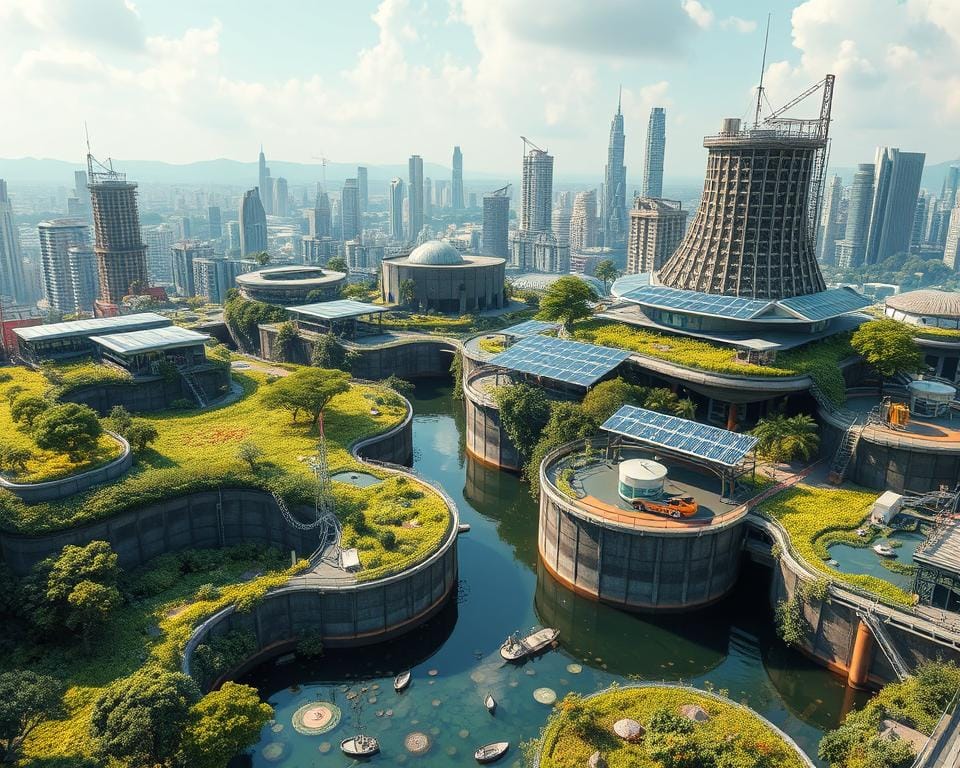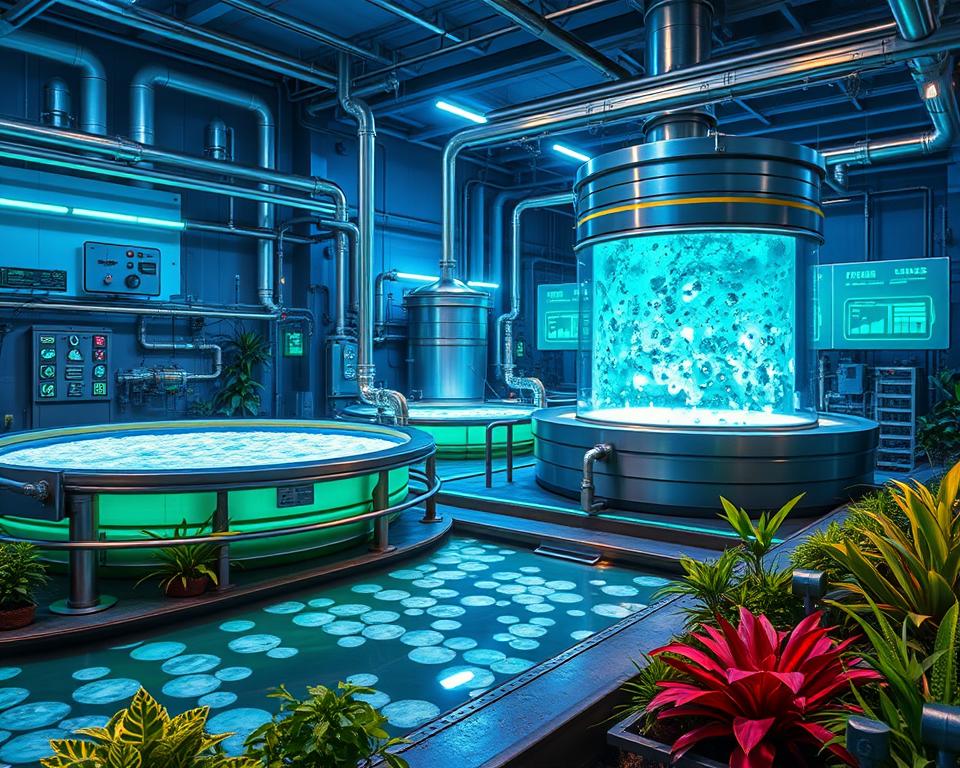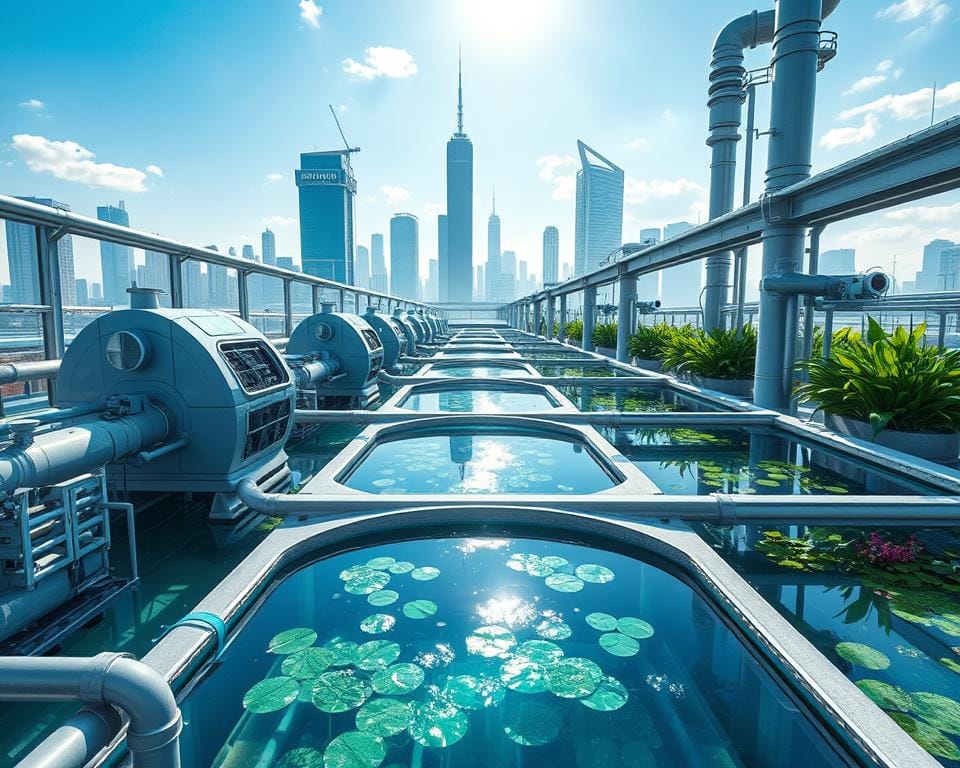The water industry is witnessing exciting advances in wastewater treatment. These breakthroughs make us rethink how we handle wastewater in cities and factories. Epic Cleantec is leading the charge with technology that recycles up to 95% of a building’s wastewater. This shows on-site recycling is not only doable but also sustainable.
Battling tough contaminants like PFAS is becoming more effective. With Enspired Solutions’ Reductive Defluorination and Aclarity’s approach, PFAS turns into less harmful chemicals. Moreover, the rise of real-time water quality monitoring uses AI and sensors. This tech gives us immediate insights into water quality, helping with quick decisions.
But it’s not all about the big players. Small-scale setups benefit too. Aquacycl’s BioElectrochemical Treatment system cuts down greenhouse emissions by up to 90%. And BioFiltro’s BIDA® System can eliminate up to 99% of pollutants quickly. These innovations prove that advanced tech can revolutionize wastewater recycling and support a sustainable water cycle.
Introduction to Wastewater Recycling Technology
Wastewater recycling involves sophisticated technology for treating and reusing water. It helps homes, communities, and industries use water wisely, especially where water is scarce. By recycling water, we use less fresh water, which is crucial for the planet.
Reusing wastewater cuts costs and lessens the need for fresh water. Thanks to processes like ultrafiltration and reverse osmosis, recycled water can be made pure enough for drinking. Places like Windhoek in Namibia and parts of the U.S. are already benefiting from these advanced recycling methods.
Recycling water not only saves it but also helps us get energy from wastewater. Using technologies like microbial fuel cells, we can turn waste into energy. This is a big step towards using our resources wisely and making sure we have enough water for the future. Innovative techniques like electrocoagulation play a big role in cleaning water efficiently.
Recycling helps protect nature and makes sure our water is clean. However, getting people to trust and use recycled water is a challenge. We need to educate and involve everyone to make wastewater reuse a common practice. This way, we all support keeping water clean and available.
To learn more about recycling water and its uses in industry, check out this resource.
- Energy Recovery through Wastewater Streams: Using new tech to turn waste into energy.
- Advanced Technologies for Wastewater Recycling: Leading innovations for cleaner water.
- Sustainability Benefits: Keeping our ecosystems safe and water clean.
| Wastewater Recycling Methods Tool | Highlighted Benefits |
|---|---|
| Ultrafiltration and Reverse Osmosis | Potable Water Quality Achieved |
| Advanced Oxidation Processes | Direct Potable Reuse |
| Microbial Fuel Cells | Energy and Resource Recovery |
Advancements in recycling are key to our future. By staying informed and supportive, we ensure water is wisely managed for coming generations.
Water Reuse and Circular Economy in Wastewater Treatment
To manage water sustainably, we must embrace water reuse and its circular economy benefits. These innovative approaches are key. They ensure our water resources are used wisely.
Understanding Water Reuse
Water reuse means cleaning wastewater so it can be used again. This is crucial in areas without much water. Through Reverse Osmosis (RO), we can clean industrial wastewater for reuse. It’s useful for many processes like cooling and chemical manufacturing.
RO systems are efficient at removing pollutants. These include dissolved solids, heavy metals, and organic materials. Their versatility makes them essential for sustainable water management.

Benefits of Circular Economy Approaches
The circular economy is about recycling and efficient use of resources. It brings big benefits to water management. Using RO in manufacturing saves water and decreases wastewater. It’s a key step towards sustainable water management.
It also saves money by reducing the need for fresh water. And, it lowers the costs of treating wastewater. Companies like Epic Cleantec and HydraLoop are at the forefront with innovative treatments. These setups help reduce pollution and meet social responsibility goals.
| Water Reuse Implementation | Circular Economy Benefits |
|---|---|
| Reduces dependence on freshwater sources | Encourages the efficient use of resources |
| Minimizes wastewater discharge | Supports sustainable water management |
| Substantial cost savings in water procurement | Promotes corporate social responsibility |
Clearly, implementing water reuse and adopting circular economy principles are crucial. They lead to sustainable water management and conservation. This ensures a future that’s resilient and efficient in using resources.
Innovative Technologies for PFAS Destruction
The push to solve PFAS pollution has led to new technologies. Enspired Solutions and Aclarity are leaders in this effort. They are creating ways to fight this tough environmental problem.

Enspired Solutions’ PFAS Reductive Defluorination
Enspired Solutions uses a method called PFAS reductive defluorination. It breaks down PFAS chemicals using ultraviolet light. This process significantly lowers PFAS levels, improving water quality and helping industries meet environmental laws.
Aclarity’s PFAS Destruction Technology
Aclarity shines with its electrochemical oxidation (EOx) technology. It uses electrons to separate PFAS chemicals. EOx is energy-efficient and works at room temperature. It’s perfect for treating large amounts of PFAS.
It’s easy to add to existing systems without causing trouble. This makes Aclarity’s approach very appealing. It lowers energy use and fights PFAS pollution effectively.
Enspired Solutions and Aclarity are making great strides in PFAS destruction. They tackle the PFAS threat and follow environmental laws. This protects communities and nature.
- Enspired Solutions employs ultraviolet PFAS dismantling to break down carbon-fluorine bonds.
- Aclarity uses electrochemical oxidation (EOx) for efficient and cost-effective PFAS destruction.
- EOx technology minimizes energy requirements and integrates seamlessly with existing site operations.
- PFAS reductive defluorination and EOx are crucial for future-proofing against environmental and regulatory risks.
For costs and how to set up these technologies, see the installation cost guide.
Breakthroughs in Wastewater Recycling Methods
Wastewater treatment has seen major breakthroughs lately, with important steps forward in recycling efforts. A big leap is the adoption of Membrane Bioreactors (MBRs). They make treatment more efficient and need less space. Also, turning waste into biogas through anaerobic digestion is a key development. It shows how we can reuse water in a sustainable way.
Another technique, Advanced Oxidation Processes (AOPs), breaks down hard-to-remove pollutants. By mixing innovative methods with smart tech like AI, we are making water treatment better. And with the help of nanotechnology and new materials, we can remove more pollutants and even recover resources. This marks a huge step in making water treatment better.
New trends like resource recovery and the circular economy are becoming more popular. They highlight the value of better wastewater treatment methods. Constructed wetlands, for example, use nature’s own methods to clean water. And by turning wastewater into useful resources like fuel and fertilizer, we add value to what was once waste.
Yet, high costs remain a big hurdle for using these new technologies everywhere. There are also tough rules that make it hard for many sectors to adopt these methods.
More and more, wastewater plants are becoming places where resources are recovered. They aim to use water in a way that doesn’t harm the environment. Industries, like chip makers, are adopting systems that don’t waste any water. Technologies like the MAX H2O Desalter are changing how we manage water.
As rules on PFAS get stricter, finding ways to handle and treat these chemicals is crucial. Technologies based on reverse osmosis membranes are part of the solution. Moving towards a sustainable future, companies are mixing their goals with efforts to protect the environment. They use innovative methods and advanced treatments to preserve our planet.
Advances in Domestic and Municipal Wastewater Treatment
Wastewater treatment has made big leaps recently, both at home and in cities. These new technologies help in managing water better and keeping the environment safe. They improve water quality and make sure we use water wisely.
Domestic Innovations
At home, new tech like Rainstick’s shower system is changing the game. It saves up to 80% of water by recycling shower water. Alongside, methods like ultrafiltration and reverse osmosis make reused water clean for other uses. These innovations help houses use water more smartly.
Ultrafiltration acts like a super-fine filter, catching tiny particles. This makes home water management more sustainable.
Municipal Innovations
In cities, new treatments like worm-based filtration and algae systems are making waves. They handle waste better and recycle nutrients. Technologies like advanced oxidation break down tough pollutants. The California Water Plan Update dives deeper into these advances.
Other approaches, like phosphorus removal, fight water pollution. They keep lakes and rivers clean.
New tech plays a big role in improving wastewater treatment. IoT devices help monitor treatments in real-time. This leads to better control and efficiency. Zero-liquid discharge systems show progress by cutting down waste and reusing water in industries.
This progress is not just about following rules but also about saving more water. For more on water-saving methods, see this article on distilling water. These advances promise a future where water is cleaner and more secure for everyone.

